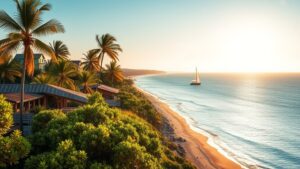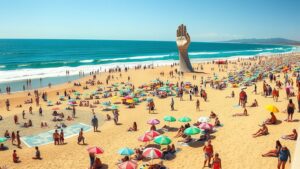Punta del Diablo, Uruguay, is a coastal village, founded in 1935, with a growing tourist industry, significant population surge, and environmental concerns, prompting further investigation, into its development.
Key Takeaways
- Punta del Diablo is in Rocha Department, Uruguay.
- Founded in 1935 for therapeutic sea air benefits.
- Population surges to 25,000 during peak tourism.
- Offers surfing, hiking, and horseback riding activities.
- Features Santa Teresa National Park with 60 km trails.
Location Overview
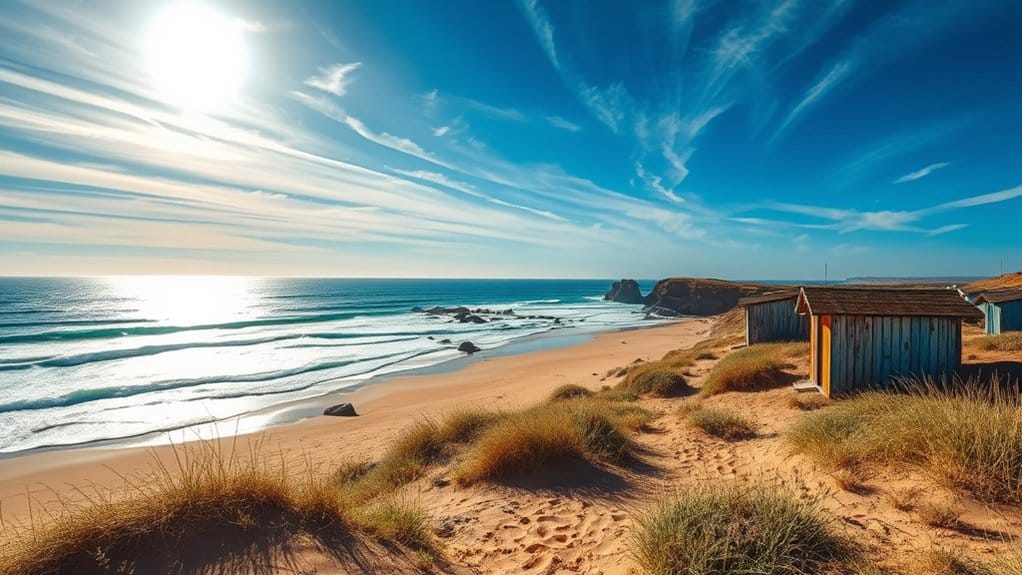
Punta Del Diablo, Uruguay, is situated in a unique geographical position, located in the Rocha Department, approximately 298 kilometers east of Montevideo, the capital of Uruguay, and 172 kilometers from Punta del Este, a popular tourist destination. This location holds significant geographical significance, with cultural influences shaping its identity. The area’s proximity to the Brazilian border, approximately 40 kilometers away, adds to its distinct character, with the Atlantic Ocean to the east and Negra Lagoon to the west, creating a diverse terrain, full of contrasts, freedom, and natural beauty, making it an attractive destination. The picturesque fishermen village is known for its handicrafts market where visitors can purchase unique local crafts as souvenirs, supporting local artisans and contributing to the cultural richness of the village.
Population Insights
As the number of inhabitants in this coastal town continues to grow, albeit at a relatively slow pace, the demographic environment is becoming increasingly intricate, with a notable surge in population size over the years, from 199 inhabitants in 1985 to 823 inhabitants in 2011, representing a significant, yet manageable, increase. Population trends, demographic shifts, indicate growth. The town’s location near the ocean and its temperate climate make it an attractive destination for tourists and residents alike.
| Year | Population |
|---|---|
| 1985 | 199 |
| 1996 | 318 |
| 2011 | 823 |
Freedom, and accessible living, are key.
Climate Conditions
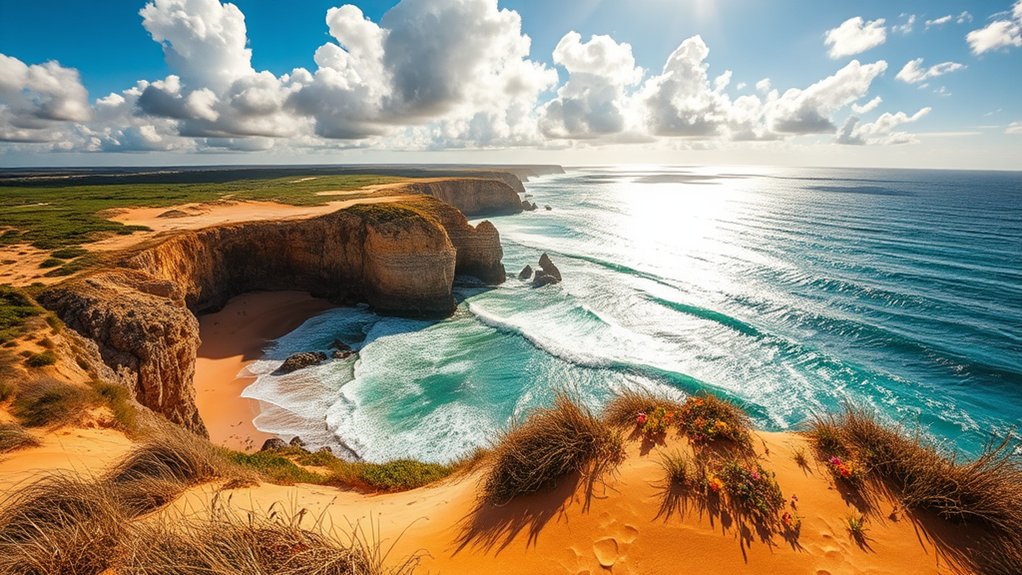
Climate conditions in this coastal town are a intricate, multifaceted entity, characterized by moderate temperature variations, significant rainfall, and dramatic changes in sunshine hours, all of which contribute to a unique, yet challenging, environment. Temperature trends show moderate fluctuations, while precipitation patterns remain consistent, with minimal variation between months. The town experiences significant rainfall, averaging 1260 mm annually, with the wettest month being June, and the driest, December. These climate conditions, marked by distinct temperature trends and precipitation patterns, shape the town’s environment, making it a place of dramatic contrasts, where freedom and resilience are essential. The availability of precise forecasts enables visitors to plan their trips effectively, taking into account the unique climate conditions of the area.
Tourism Industry
The tourism industry in Punta Del Diablo, Uruguay, is characterized by a high season that runs from December to February, and during Easter week, which significantly impacts the local economy, leading to a substantial increase in population, and subsequently, a surge in economic activities. During this period, the area’s population swells from 823 permanent residents to approximately 25,000, resulting in a massive influx of tourists, mostly from Argentina, Brazil, and Europe, who contribute to the local economy through their spending on accommodation, food, and activities. The tourist season, in turn, drives the local economy, with tourism being a primary source of income, and associated services like hotels, shops, and restaurants, playing an essential role in supporting the local fishing community, and catering to the needs of visitors. The village offers a range of accommodation options, including cabins and hotels, to suit the needs of different tourists, from budget-friendly to more luxurious choices, and this diversity in lodging contributes to the area’s appeal as a tourist destination.
Tourist Season
How does a small village like Punta del Diablo, with a permanent population of merely 823 residents, manage to accommodate a massive influx of tourists during peak season, with numbers swelling to approximately 25,000? The village experiences significant seasonal variations, with tourist demographics shifting during high season. Key factors include:
- Tourist demographics
- Seasonal variations
- Accommodation availability
- Activities and attractions. The village’s tourist season is characterized by increased activity, catering to diverse freedom-seeking visitors, with a range of options, from surfing to hiking, available during peak season, from December to February, and Easter week. The area maintains a relaxed vibe with colorful cabins and dirt roads, making it an attractive destination for tourists looking for a unique experience.
Local Economy
Numerous economic activities converge in Punta del Diablo, with tourism emerging as the primary driver, focused on sun and beach tourism, and associated services like hotels, shops, and restaurants catering to the influx of visitors. The local economy also benefits from fishing practices, providing a significant source of income. Additionally, artisanal products contribute to the economy, showcasing the village’s roots. With a growing tourist industry, Punta del Diablo is determined to maintain its charm, balancing growth with preservation of its rustic, bohemian feel, and ensuring that economic development benefits the local community, while promoting sustainable practices. The village’s strategic location and natural beauty are likely to attract more visitors from neighboring countries, particularly from Argentina, due to its proximity and cultural affinity.
Activities And Attractions
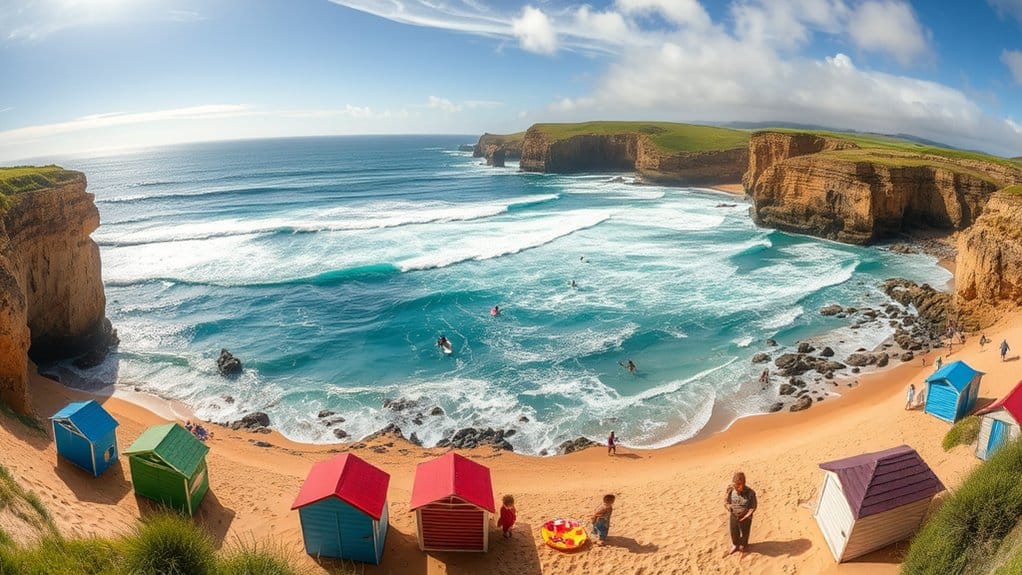
Punta del Diablo, Uruguay offers a wide range of activities and attractions, including beach activities, such as surfing, sunbathing, and sports like jogging, at popular beaches like Playa de la Viuda and Playa del Rivero. The town is also home to Santa Teresa National Park, a 3,000-hectare park with 60 km of hiking trails, featuring flora and fauna, including rare cormorants, and offering opportunities for hiking, horseback riding, and other outdoor activities. With its unique combination of beach and national park activities, Punta del Diablo provides a diverse and exciting experience for visitors, from water sports and sunbathing to hiking and exploring the local flora and fauna, making it an ideal destination for those seeking adventure and relaxation. The town’s natural beauty and outdoor recreational opportunities make it a great spot for ecotourism and nature lovers, with its parks and beaches providing a perfect setting for exploration and enjoyment.
Beach Activities
Several beaches in Punta Del Diablo, Uruguay, offer a range of activities, including swimming, water sports, and relaxation, making it an ideal destination for tourists. Visitors can enjoy beach games, sunset yoga, and other activities. Some popular activities include:
- Surfing and water sports
- Beach hiking and dune boarding
- Sport fishing and horseback riding
- Relaxation and sunbathing, allowing individuals to unwind and connect with nature, experiencing freedom and tranquility in this beautiful setting, with various options to choose from, catering to different preferences and interests, ultimately creating a unique experience. The town’s population significantly increases during the summer season, attracting many tourists and providing a vibrant atmosphere with numerous events and activities.
National Park
Because the national park is a critical component of Uruguay’s ecosystem, it demands attention and protection, featuring a diverse range of flora and fauna, with approximately 2 million trees, and encompassing an area of 3,000 hectares, which is a significant portion of the country’s Atlantic Coast. The park’s unique blend of scenic views and outdoor activities, such as horseback riding, supports wildlife conservation, ecological education, promoting freedom to discover, with diverse terrains, and historical sites, making it a unique destination.
| Aspect | Importance | Impact |
|---|---|---|
| Wildlife | High | Conservation |
| Ecological Education | Medium | Understanding |
| Tourism | Low | Economic |
| Freedom | High | Discovery |
Economic Development
As tourism continues to drive economic growth in this small coastal town, the need for sustainable development becomes increasingly pressing, with local officials, business owners, and residents working tirelessly to balance the influx of visitors with the preservation of their community’s character. Key factors include:
- Sustainable tourism
- Community investment
- Infrastructure development
- Environmental protection. The town’s laid-back atmosphere is influenced by its population of approximately 1,200 people, offering a quiet and safe environment, which contributes to its appeal for tourists and residents alike. They strive for a balance between economic growth and preserving their way of life, promoting freedom and autonomy, while addressing challenges like inadequate infrastructure and soaring prices, to create a thriving community that supports both locals and visitors, fostering a sense of freedom.
History And Founding
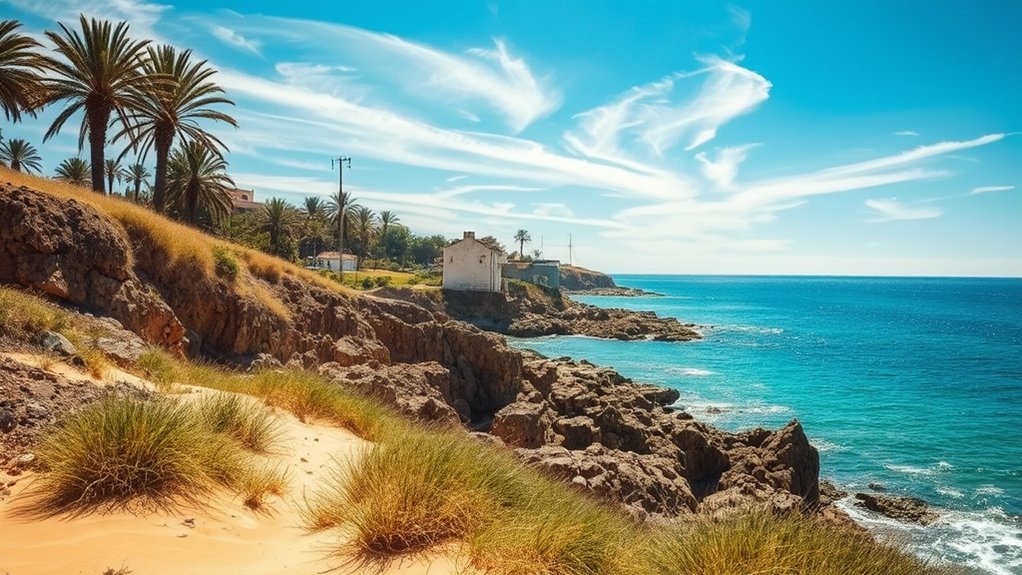
The town of Punta del Diablo, Uruguay, was founded in 1935 by the Rocha family, who, driven by desperation, sought the area’s therapeutic sea air to alleviate their child’s debilitating asthma attacks, and in doing so, inadvertently laid the groundwork for a thriving community. The Rocha family’s decision, rooted in asthma origins, led to settlement. Fishermen from Valizas arrived later, contributing to growth. Initially inaccessible by road, the area developed slowly, with the first road built in 1968. The Rocha family’s bold move sparked independence, paving the way for a vibrant, liberated community, shaped by its unique history. The location of Punta del Diablo, with its temperate climate, played a significant role in attracting early settlers and shaping the community’s development over time.
Environmental Conservation
Punta del Diablo’s environmental conservation efforts are underway, driven by necessity, with protected areas like Cerro Verde, Uruguay’s first Coastal-Marine Protected Area, playing an essential role in preserving biodiversity, while also addressing pressing environmental concerns, such as poor sewage disposal. Conservation strategies, and community engagement are vital.
- Protected areas management
- Community participation
- Ecotourism development
- Environmental monitoring, are key to conservation success, ensuring freedom to thrive in a healthy environment. The park’s visiting hours are structured to promote a balance between human activity and the preservation of natural habitats, allowing for the coexistence of local wildlife and tourists.

